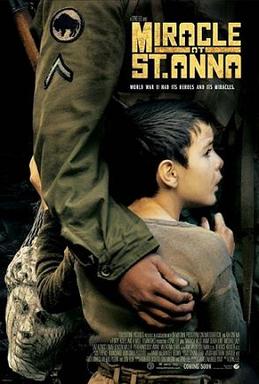Miracle at St. Anna Dir. Spike Lee (2008)
 Miracle at St. Anna is an American-Italian war film, the genre of the film is historical fiction. Several themes ran throughout the film which include Religion, Family, Betrayal, Unrequited love, war and Friendship. The film was filmed and made in 2008 and was directed by Spike Lee and was written by James McBride. The films locations include America, Italy and Port Nassau in the Bahamas. The production companies for the film were Spike Lee's own production company 40 Acres and a Mule film works, Touchstone pictures and RAI Cinema, while Walt Disney Studios and Motion pictures distributed the film. The films budget was $45 million, at the box office the film only grossed $9.3 million and made $10.1 million from DVD sales, which totalled $19.4 million overall.
Miracle at St. Anna is an American-Italian war film, the genre of the film is historical fiction. Several themes ran throughout the film which include Religion, Family, Betrayal, Unrequited love, war and Friendship. The film was filmed and made in 2008 and was directed by Spike Lee and was written by James McBride. The films locations include America, Italy and Port Nassau in the Bahamas. The production companies for the film were Spike Lee's own production company 40 Acres and a Mule film works, Touchstone pictures and RAI Cinema, while Walt Disney Studios and Motion pictures distributed the film. The films budget was $45 million, at the box office the film only grossed $9.3 million and made $10.1 million from DVD sales, which totalled $19.4 million overall. The use of a hand-held camera in the battle scenes helps makes the audience feel more involved in the film and makes them feel like they are there with the characters. The hand-held camera is used to emphasise the chaos within the scene, all the gunfire and explosions, the soldiers screaming and shouting in pain at being shot or having limbs blown off. The close-ups of the characters helps to show the pain and anguish they are enduring in the battle and shows their body language towards the events that are happening. We see the effect that the war can have on soldiers at 00:16:23, when one of the soldiers in the Army Platoon starts to become scared and nervous praying for his mum to come and help him. The close-ups and mid-shots of the soldier when he is going through this situation shows his body language and his emotions. Spike uses these shots to shows how scared and petrified soldiers could be when it came to war and when you were called upon to go out to find and fight the enemy army. Not only does it help show emotion and body language, it helps us to sympathise with the characters and almost feel what they are going through.
The use of a hand-held camera in the battle scenes helps makes the audience feel more involved in the film and makes them feel like they are there with the characters. The hand-held camera is used to emphasise the chaos within the scene, all the gunfire and explosions, the soldiers screaming and shouting in pain at being shot or having limbs blown off. The close-ups of the characters helps to show the pain and anguish they are enduring in the battle and shows their body language towards the events that are happening. We see the effect that the war can have on soldiers at 00:16:23, when one of the soldiers in the Army Platoon starts to become scared and nervous praying for his mum to come and help him. The close-ups and mid-shots of the soldier when he is going through this situation shows his body language and his emotions. Spike uses these shots to shows how scared and petrified soldiers could be when it came to war and when you were called upon to go out to find and fight the enemy army. Not only does it help show emotion and body language, it helps us to sympathise with the characters and almost feel what they are going through.Racism was a key theme shown in the film by Spike. He showed how the whites used their colour as a position of power and use it to show their superiority above the blacks. A scene where this was indicated was when the soldiers wanted to eat in a café which was occupied by other white Americans and the owner treated the blacks in a patronising and derogatory way by telling them to sit out the back like dogs away from the whites. Close up shots of the all the soldiers face showed their emotions of how they was upset and violated at the fact four white German guys got to sit in a booth despite the fact they are the people they are at war with, and despite the fact they are serving in the Army helping the country, they still get no respect from anyone. However, they repeat their action a while; they went back to the café with an aggressive and violent approach towards the owner and the other white people in there, the owner was intimidated and scared because they were all brandishing weapons.
T thIs is encouraging, whilst your peers seem to want to rush their writing and get it out of they way, you seem to enjoy it! You start with some great background contextual set up, box office figures and budgets this would have been better if you would have compared it to Spikes other films or that of Tarantino's Inglourious Basterds. You touch on the narrative, cinematography and a theme of race and you raise pertinent points on all. However in order to push for the higher grades use CCCEO throughout. How many of these elements do you think that you have used here? Well Done T.
ReplyDelete